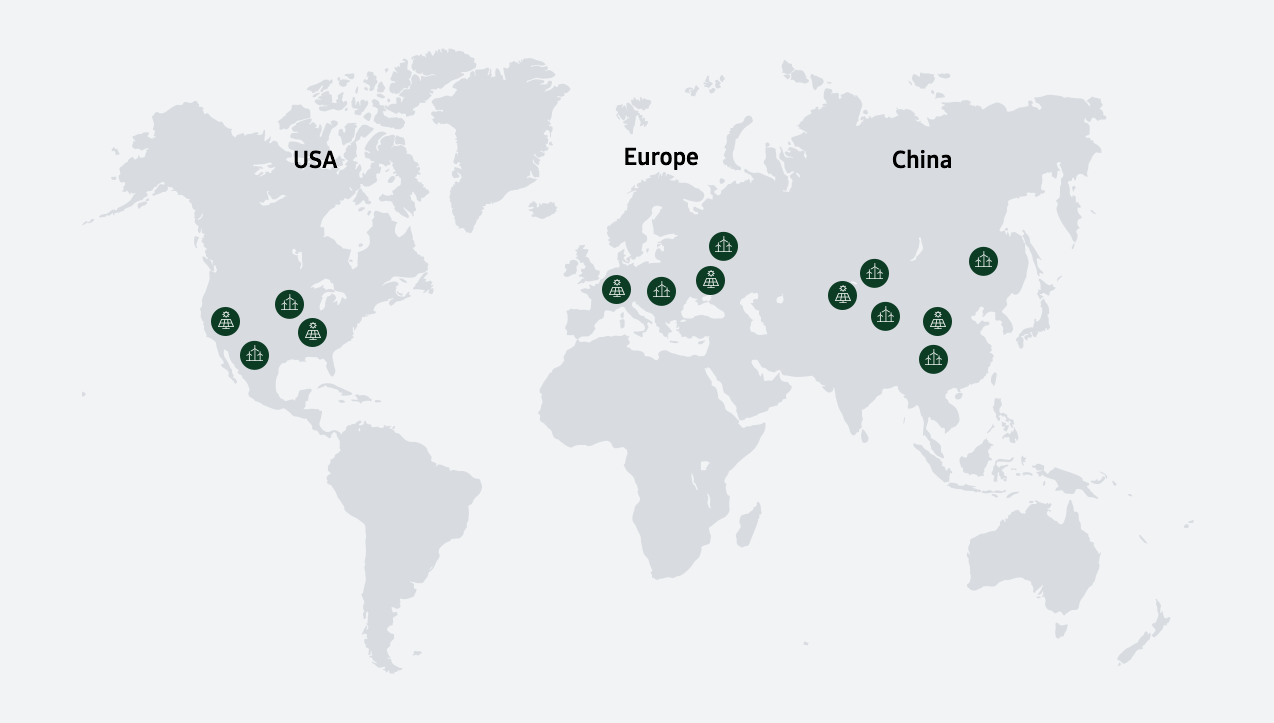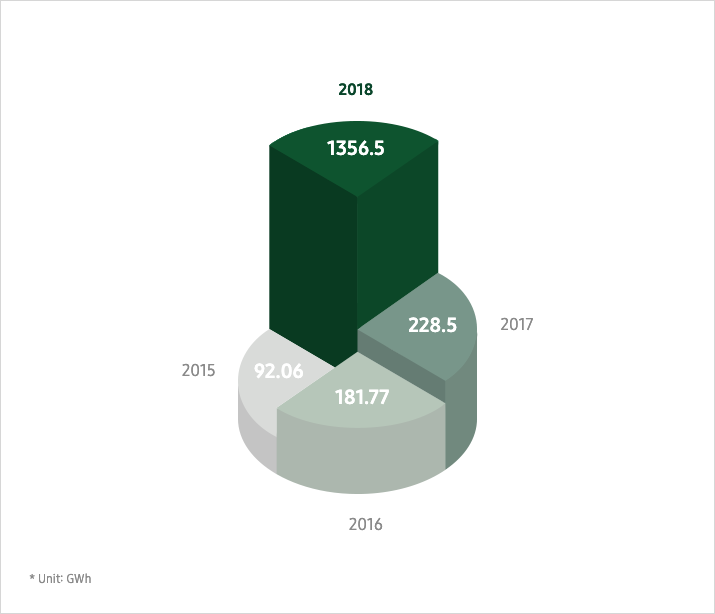Acting now for a sustainable,
low-carbon future

Climate change, resulting at least in part from a surge in the use of fossil fuels and the global warming it has caused, is a serious problem that affects the entire world. Samsung Electronics has acknowledged the reality of the crisis and is therefore continuing efforts on multiple fronts. These include developing highly energy-efficient products, installing equipment with minimum greenhouse gas (GHG) emissions, and harnessing new and renewable energy.
Climate Change Performance 2020 KPI

Intensity-based GHG Emissions
for Global Worksites

Cumulative Greenhouse Gas Reduction
in Product Use Phase
We are focused on responding to the climate change crisis
With its advanced product technologies, Samsung Electronics is evolving as we seek to enable a more environmentally responsible and convenient way of life. To achieve this goal, Samsung operates companywide eco- consulting group meetings twice a year. Through these meetings, Samsung shares information about environmental requirements and the development of innovative technologies among environmental experts of business divisions, and researches energy-saving technologies to develop products with high energy efficiency. In 2017, Samsung introduced products with highly energy efficient technologies such as Quick Drive for washing machines and highly efficient fans in external units of air conditioners, improving energy efficiency by an average of 36% compared to 2008. These energy efficiency improvements reduced the consumer’s energy consumption and energy costs, as well as greenhouse gas emissions.

We are expanding our emissions management at all levels
Problem solving requires accurate information. To precisely measure and manage our greenhouse gas emissions, we have categorised them into three scopes which are defined by the GHG Protocol based on their proximity to business and operation. Locating the exact point of emission at each level is the basis for managing greenhouse gases in the optimal way.Scope 1 refers to greenhouse gases emitted when products are manufactured at Samsung Electronics’ worksites, while Scope 2 indirect emissions are associated with worksites’ energy purchases to generate electricity and steam. Scope 3 covers non-worksite emissions, such as those from logistics activities, business trips, our supply chain, and the use of our products. We use this analysis to systematically manage all emissions, whether direct or indirect, from our worksites, use of products and our suppliers.

· Monthly analysis of global worksite emissions based on GHG management system
· Installed GHG decomposition equipment in semiconductor processing, with a decomposition rate of 90% and higher
· Installed high-efficiency equipment and converted indoor lighting to LED at global worksites

∙ Execute greenhouse gas reduction projects to improve energy efficiency in logistics.
∙ Discover greenhouse gas reduction projects through on-site support for major vendors.
∙ Increase the use of video conferencing and reduce the number of international business trips.


* Unit: Million tCO2
* Scope of data collection: Eight major product categories(mobile phones, notebooks, TVs, monitors, refrigerators, washers, air conditioners, and printers)
* Accumulated since 2009
We use advanced technology to improve energy efficiency
With its advanced product technologies, Samsung Electronics is evolving as we seek to enable a more environmentally responsible and convenient way of life. To achieve this goal, Samsung operates companywide eco- consulting group meetings twice a year. Through these meetings, Samsung shares information about environmental requirements and the development of innovative technologies among environmental experts of business divisions, and researches energy-saving technologies to develop products with high energy efficiency. In 2017, Samsung introduced products with highly energy efficient technologies such as Quick Drive for washing machines and highly efficient fans in external units of air conditioners, improving energy efficiency by an average of 36% compared to 2008. These energy efficiency improvements reduced the consumer’s energy consumption and energy costs, as well as greenhouse gas emissions.


Increase in production volume requires an increase in the number of manufacturing locations and a corresponding increase in energy consumption. To reduce energy used as we grow our manufacturing capacity, Samsung has established 24 Energy Saving Standards for efficient production. In the case of new locations, energy saving technologies were developed considering the characteristics of the facility and utilized from early stages of the process design to improve energy efficiency. As a result, despite production increase, we saved 34.3 billion KRW in power and utilities costs of overseas locations in 2018.


At Samsung Electronics, we are constantly expanding the use of renewable energy.
As a leading global IT company, Samsung Electronics has been expanding the use of renewable energy as a response to climate change and officially announced major targets in June, 2018.
- We will transition to 100% renewable energy in all our worksites in the United States, Europe, and China by 2020.
Samsung Electronics has set a short-term goal of expanding the use of renewable energy starting in the United States, China, and Europe, where there is sufficient infrastructure for using renewable energy, and has been working hard to meet the goal.
First, we have shifted to 100% renewable energy for all electricity used in the regional headquarters and the semiconductor worksite in the United States in 2019, while also preemptively achieving 100% renewable energy transition in the Slovak worksite in Europe. Moving forward, we plan to transition to regionally appropriate renewable energy gradually in other worksites in the United States and Europe. Moreover, we have installed a 5.5MW photovoltaic power generating facility on the rooftops of the buildings of our TV and semiconductor worksites in China. Just as in Korea, all of the generated power is being used for the operation of the production and ancillary facilities.
- We will install photovoltaic and geothermal power generation facilities in parking lots and on rooftops of all our domestic worksites such as Suwon, Hwaseong, and Pyeongtaek by 2020.
To stay in line with the Korean government’s target of expanding the use of renewable energy to 20% by 2030 and to 30 to 35% by 2040, the Suwon worksite of Samsung Electronics has installed photovoltaic power generation facilities with a total capacity of 1.9MW in the parking tower and on the rooftops of five research facilities as a domestic pilot project. The power generated by the photovoltaic facilities are being directly used for the relevant research and parking facilities. By monitoring the results of the pilot photovoltaic facility installation, we plan to continuously introduce photovoltaic and geothermal power generating facilities also in logistics centers and other large worksites in Hwaseong and Pyeongtaek by 2020
- By joining the CDP Supply Chain in 2019, we plan to recommend our 100 most important business partners to establish a target for renewable energy use.
To support the expanded use of renewable energy by our business partners, Samsung Electronics plans to join the CDP Supply Chain to make our 100 most important business partners based on purchase amount establish a target for renewable energy use and expand the use of renewable energy while playing a role in creating a healthier environment.

We are conducting research and projects to adjust to climate change
To find ways as a company to respond and overcome changes in the climate, since 2015 we have been conducting a joint study titled CSR Activities to Adjust to Climate Change. Together with the Graduate School of Environmental Studies at Seoul National University, our researchers have taken on assignments under three themes: access to drinking water, energy-efficient housing and climate change education.
As a part of the drinking water project, we installed semi-permanent drinking water facilities at 10 locations in Vietnam that have struggled to secure a stable supply of potable water. As a result, local residents no longer worry about access to water, a substance vital to life even during the most serious drought. Meanwhile, our Housing Renovation Projects for the underprivileged have been upgraded to what we call the Housing Energy Efficiency Improvement Construction Project. This project provides households with a living environment that saves energy and insulates them from hot summers and cold winters at a low cost. A study of 61 households in 2017 showed that the average amount of energy used per household throughout the year was reduced by half, resulting in lower energy costs for the vulnerable members of society. These efforts didn’t end in just economic gains. It also led to reducing associated greenhouse gas emissions related to power generation by 43 tons CO2e per year.
Lastly, we developed specialized educational content about climate change on the Samsung Smart School platform for teachers and students to use. Using such content, we nurtured 300 expert lecturers, and offered demonstration classes for 2,200 children at 11 elementary schools. With such efforts, we helping our future generation understand how serious climate change is and how important it is that we work to resolve it.


